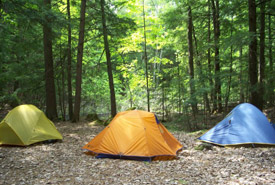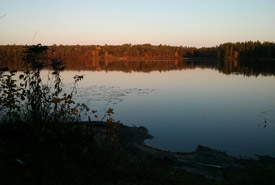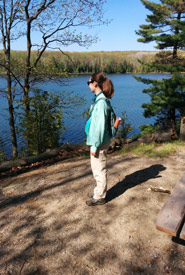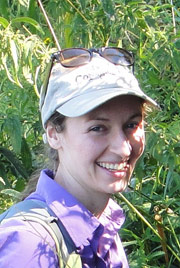#HowToNature series: How to camp (Part One)

Set up your tent in a flat, open space away from the campfire pit and cooking area. (Photo taken at Silent Lake Provincial Park by Cara Copeland)
Camping is one of my favourite ways to experience nature. I love the fresh air, waking up to the sound of birds chirping, and taking the time to slow down and just enjoy being outside.
Camping is a broad topic – generally speaking, it involves staying overnight in a wilderness setting, but beyond that it can be a highly variable experience. Some folks like to drive right up to their campsites and sleep in a recreational vehicle (aka an RV), while other people might prefer to hike or paddle to a remote destination and pitch a tent. Still others might opt to sleep under the stars in their own back yards. There are so many great options!
Most of my childhood camping experiences were of the "drive up to the campsite and pitch a tent" variety, so that’s what I’ll focus on today. It’s a good format for a novice camper – you don’t need a lot of equipment, and it’s not too challenging to plan.

Early autumn is a great time for camping – no mosquitoes or black flies – but be prepared for cooler overnight temperatures! Photo taken at Bon Echo Provincial Park by Jason Snell)
Where to camp
Choosing a camping destination can be intimidating, but looking for a campground close to where you are setting off on your adventure can be a good place to start.
There are National Parks in every Canadian province and territory. Provincial and territorial governments each operate parks as well, and there are privately-owned campgrounds all over. An internet search of camping recommendations in your area can help narrow things down.
If you don’t have access to a car, you’re not necessarily out of luck. For readers in Toronto, Parkbus runs a paid shuttle service between Toronto and many Ontario camping destinations. Bike camping is another option for those up who don’t mind peddling the distance. You’ll need to pack light if choosing to go this route! If you have suggestions for alternative ways to access camping across the country, I’d love to hear about it in the comments section!
What to pack
While camping does require a certain amount of gear, it doesn’t have to cost an arm and a leg. Purchasing brand new equipment can be a good investment if you think you’ll do a lot of camping in the future, but you can also buy some great used stuff (there are plenty of camping "gearheads" selling their perfectly good equipment in order to upgrade to fancy-super-technical-what-nots).
In some areas you might be able to rent equipment from a park or local outfitter. Borrowing from a friend or family member is another great option if you’re starting from scratch.
Here are my recommendations for what you’ll need to be a happy camper:
Sleeping
- Tent with fly to keep the rain off
- Sleeping bag
- Sleeping pad or mattress
- Something soft to rest your head on: It could be a pillow from home, a small travel pillow or even a balled-up sweatshirt
Cooking
- Camp stove and compatible fuel
- Matches or lighter
- Dishes: At a minimum I’d recommend a pot, heat-resistant spoon or spatula, a sharp knife for food preparation, small cutting board, and a bowl, mug, and cutlery for each person. If you have space, a small frying pan is handy. Plates are also nice to have but if you’re tight for space then bowls are a passable substitute (I can confirm it’s possible to eat steak and baked potatoes out of a small plastic bowl!).
- Biodegradable camp soap and cloth or towel for drying dishes.
- Refillable water bottles
- Cooler and food (see Part Two)

Taking in the scenery on a day hike at Awenda Provincial Park. Note the layered clothing and sturdy footwear. (Photo by Jason Snell)
Clothing
The key to comfort is layers, since you’re basically outside 24/7. Overnight temperatures can get quite chilly even if the daytime forecast is hot and sunny, especially in the spring and fall. My personal favourites include a toque and down vest (which also works great as a pillow). But as long as you have clothing for a range of temperatures, you can be creative.
Other recommended clothing
- Hat
- Rain coat and pants
- Footwear: I like to bring hiking boots for excursions and cooler temperatures, and sandals for wearing to the beach and around the campsite. For in-between temperatures I proudly rock the socks and sandals!
- Bathing suit and towel
Miscellaneous
- Flashlight or headlamp with extra batteries
- A tarp is nice to have in case of rain. You can cook underneath it (but never use a camp stove inside your tent or other enclosed space!).
- Rope or twine (handy for hanging up a tarp, makeshift clothesline, etc.).
- Bug spray, sunscreen and hand sanitizer
- Folding camp chairs and hammock (these are definitely not a necessity – most campsites are equipped with at least one picnic table).
Now that you know how to prepare for your trip, check out Part Two for what to do once you get to your campsite!


